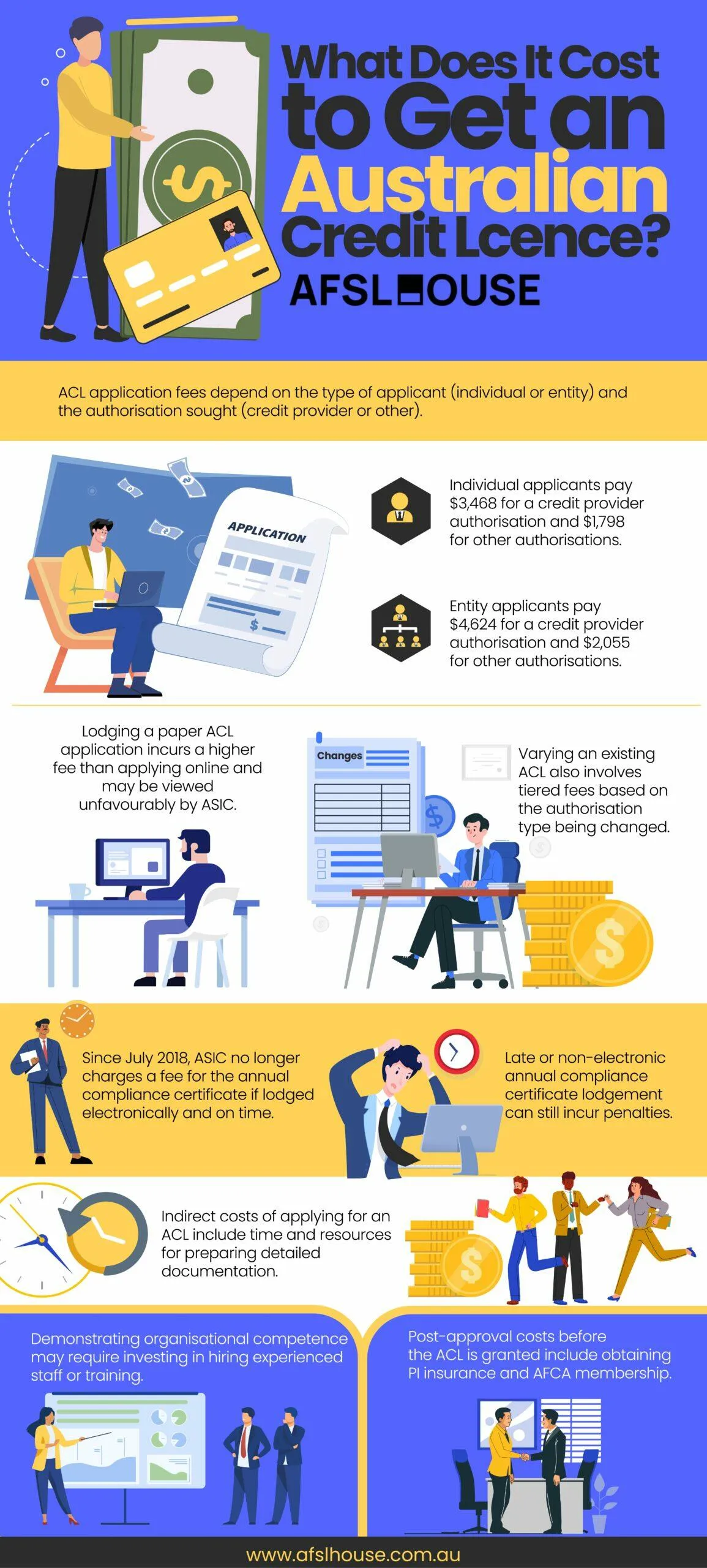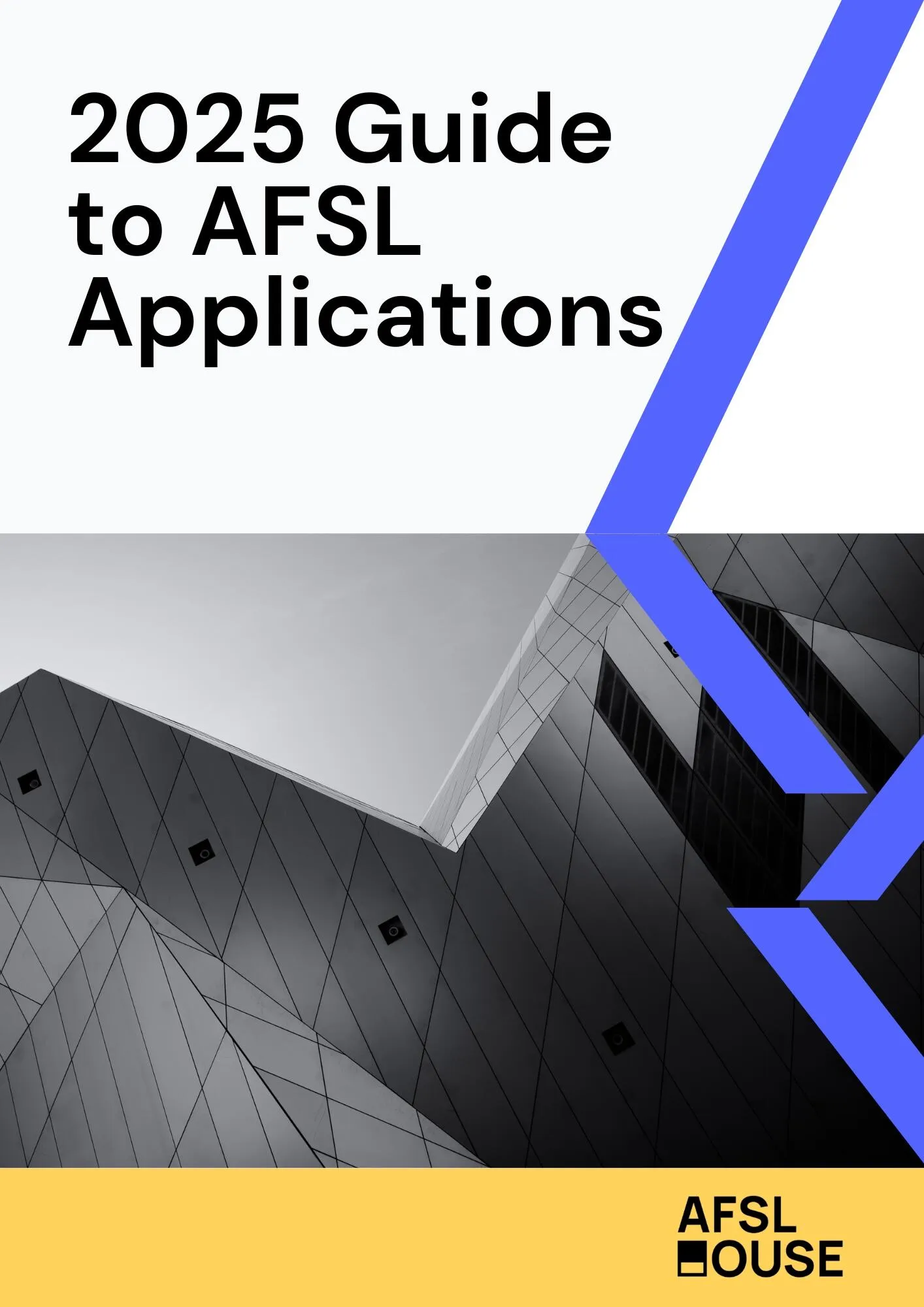Introduction
Obtaining an Australian Credit Licence (ACL) is a necessary step for businesses engaging in credit activities within Australia, as mandated by the Australian Securities and Investment Commission (ASIC). Understanding the financial commitments involved in the ACL application process and ongoing compliance is crucial for any organisation planning to offer credit services.
This guide provides a breakdown of the various costs associated with securing and maintaining an ACL. It covers the initial licence application fees, potential costs for variations, and requirements related to the annual compliance certificate, helping businesses prepare for the financial aspects of ACL ownership.

Breakdown of ACL Application Licence Fees
Application Fees Based on Applicant Type
The fee payable to ASIC for an ACL application depends partly on the type of applicant. ASIC differentiates between:
- Individuals applying for an ACL
- Entities apart from individuals (such as body corporates)
This distinction is a key factor in the tiered fee structure that ASIC has established in their fee schedule outlined in Information Sheet 108 (INFO 108).
Application Fees Based on Authorisation Sought
Another significant factor influencing the ACL application fee is the type of authorisation the applicant is seeking. ASIC distinguishes primarily between:
- Applicants seeking authorisation as a ‘credit provider’
- Those seeking ‘other’ types of credit authorisations
The complexity associated with being a credit provider generally results in a higher application fee.
The specific fees outlined by ASIC are structured as follows:
| Applicant Type | Authorisation Sought | Application Fee |
|---|---|---|
| Individual Applicants | Seeking authorisation as a credit provider | $3,468 |
| Seeking other authorisations | $1,798 | |
| Applicants Other Than an Individual | Seeking authorisation as a credit provider | $4,624 |
| Seeking other authorisations | $2,055 |
These tiered fees reflect the varying complexity and regulatory oversight associated with different types of credit activities and applicant structures.
Online vs. Paper Application Fee Considerations
Applicants must choose between submitting their ACL application online or via a paper form. While both methods are available, there are important considerations to keep in mind:
- Lodging a paper application typically incurs a higher fee compared to the online submission process
- ASIC may view the choice to lodge a paper application unfavourably
Furthermore, this method could be interpreted as an indication that the applicant lacks adequate technological resources, which is a factor ASIC considers when assessing the applicant’s capacity to manage the proposed credit activities.
Speak with an AFSL Lawyer Today
Request a Consultation to Get Started.
Costs for Varying an Australian Credit Licence
Variation Application Fees for Individuals
If you hold an ACL as an individual and need to change its authorisations or conditions, a fee applies for this variation application. The specific fee depends on the type of authorisation involved.
ASIC charges the following fees for individuals applying to vary their licence under section 45(2)(b) of the National Consumer Credit Protection Act 2009 (Cth):
- Credit provider authorisation: $2,183
- Other than a credit provider authorisation: $1,156
These tiered fees reflect the assessment required for different types of licence variations.
Variation Application Fees for Other Entities
For entities other than individuals, such as body corporates, fees also apply when seeking to vary an existing ACL. Similar to individual applicants, the fee amount depends on the nature of the authorisation being varied.
The variation application fees for entities besides individuals are:
- Credit provider authorisation: $2,826
- Other than a credit provider authorisation: $1,284
Understanding these costs is important when considering changes to your business’s credit activities under your existing licence.
Annual Compliance Certificate Cost
Lodgement Fee Changes
Holding an ACL involves ongoing compliance obligations, including the submission of an annual compliance certificate. Under section 53(1) of the National Consumer Credit Protection Act 2009 (Cth), licensees must lodge this certificate each year within 45 days of their licensing anniversary.
Since 4 July 2018, ASIC has implemented a significant change regarding the costs associated with this requirement. They no longer charge a fee for lodging the annual compliance certificate when:
- It is submitted electronically
- It is submitted on time
This change simplifies the ongoing compliance costs for ACL holders who meet these lodgement criteria.
Potential Fees for Late or Non-Electronic Lodgement
While the standard lodgement fee for the annual compliance certificate has been removed for timely electronic submissions, penalties can still apply in certain circumstances. Specifically, fees will be incurred if:
- The certificate is lodged after the deadline
- The certificate is not lodged electronically
Therefore, maintaining timely and electronic submission practices is important for avoiding these additional compliance costs associated with your ACL.
Speak with an AFSL Lawyer Today
Request a Consultation to Get Started.
Other Potential Cost Considerations in the Application Process
Costs Involved in Preparing Core Proofs and Supporting Documents
Beyond the direct ASIC application fee, preparing your ACL application involves assembling various documents. This preparation requires internal time and resources, representing an indirect cost.
Key documents you must prepare include:
- A detailed business description outlining your operations
- Information identifying the individuals involved in managing the credit business
- Evidence demonstrating these individuals are fit and proper persons
- Documentation supporting your nominated Responsible Managers’ qualifications and experience
Compiling these proofs thoroughly is essential for the licence application process.
Costs Involved in Meeting Organisational Competence Requirements
ASIC scrutinises whether your business possesses the necessary organisational competence to engage in the proposed credit activities. This assessment heavily relies on the demonstrated knowledge and skills of your nominated Responsible Managers.
Ensuring you have appropriately qualified individuals may require investment in:
- Hiring experienced personnel
- Providing specific training to existing staff to meet ASIC’s standards
Demonstrating organisational competence is a critical criterion for a successful ACL application and represents a potential cost factor beyond the standard licence fee.
Costs Involved in Potential Post-Approval Requirements
Before ASIC formally grants the ACL, applicants typically need to fulfil final requirements. These often include:
- Providing proof of adequate Professional Indemnity (PI) insurance coverage relevant to the credit activities
- Obtaining membership with the Australian Financial Complaints Authority (AFCA), the external dispute resolution scheme
Both securing PI insurance and obtaining AFCA membership involve associated costs. These expenses must be factored into the overall budget when planning for an ACL application, as they are necessary steps before the licence is officially issued.
Speak with an AFSL Lawyer Today
Request a Consultation to Get Started.
Conclusion
Securing and maintaining an ACL involves several key financial considerations, including tiered application fees based on applicant type and authorisation sought, potential costs for licence variations, and ongoing compliance obligations such as the annual compliance certificate lodgement. Understanding these direct ASIC fees, alongside indirect costs like preparing documentation, ensuring organisational competence, and meeting post-approval requirements like PI insurance and AFCA membership, is crucial for businesses engaging in credit activities.
Managing the complexities of the ACL application and compliance process requires careful planning and expert guidance. For trusted expertise in handling your ACL requirements, contact the specialists at AFSL House today to ensure your business meets all necessary financial services law obligations efficiently.
Frequently Asked Questions
The application fee for an Australian Credit Licence typically ranges from $1,798 to $4,624. This range depends on whether the applicant is an individual or another type of entity, and the specific credit authorisations being sought.
Yes, Australian Credit Licence application fees vary depending on the business structure. ASIC charges different fees for individual applicants compared to entities other than individuals, such as body corporates.
Yes, fees are applicable when you apply to vary the conditions or authorisations of your existing Australian Credit Licence. These variation fees range from $1,156 to $2,826, depending on the applicant type and the nature of the authorisation being changed.
There is no specific annual fee mentioned for simply holding an Australian Credit Licence. However, licensees must lodge an annual compliance certificate, and while the lodgement fee is waived for timely electronic submissions, fees apply otherwise.
Fees will apply if you lodge your annual compliance certificate after the deadline. Timely lodgement within 45 days of your licensing anniversary is required to avoid these costs.
Yes, submitting a paper Australian Credit Licence application generally incurs a higher fee compared to lodging the application online. Furthermore, ASIC may view paper lodgement less favourably, as it could indicate inadequate technological resources.
ASIC determines the specific Australian Credit Licence application fee using a tiered structure based on the complexity of the application. Key factors include whether the applicant is an individual or another entity, and whether they seek authorisation as a credit provider or for other credit activities.
Yes, before the Australian Credit Licence is granted, you may need to budget for costs associated with final requirements. These can include obtaining adequate Professional Indemnity insurance and securing membership with the Australian Financial Complaints Authority.
You can find the exact current fees for Australian Credit Licence applications and variations by referring to official ASIC resources. Specifically, consult ASIC’s Information Sheet 108 (INFO 108) and Regulatory Guide 204 for the most up-to-date fee schedules.









